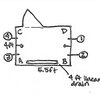PEX in electric conduit to barn
orourke
14 years ago
Featured Answer
Sort by:Oldest
Comments (15)
alphonse
14 years agolast modified: 9 years agolazypup
14 years agolast modified: 9 years agoRelated Professionals
Camarillo Kitchen & Bathroom Remodelers · Mooresville Kitchen & Bathroom Remodelers · Morgan Hill Kitchen & Bathroom Remodelers · New Port Richey East Kitchen & Bathroom Remodelers · Overland Park Kitchen & Bathroom Remodelers · Pico Rivera Kitchen & Bathroom Remodelers · Rancho Cordova Kitchen & Bathroom Remodelers · Salinas Kitchen & Bathroom Remodelers · South Lake Tahoe Kitchen & Bathroom Remodelers · Waukegan Kitchen & Bathroom Remodelers · Gibsonton Kitchen & Bathroom Remodelers · Plant City Kitchen & Bathroom Remodelers · Prairie Village Kitchen & Bathroom Remodelers · Palestine Kitchen & Bathroom Remodelers · Hewitt Kitchen & Bath Fixturesalphonse
14 years agolast modified: 9 years agoorourke
14 years agolast modified: 9 years agoalphonse
14 years agolast modified: 9 years agojake2007
14 years agolast modified: 9 years agogblentz
14 years agolast modified: 9 years agopjb999
14 years agolast modified: 9 years agoalphonse
14 years agolast modified: 9 years agobrickeyee
14 years agolast modified: 9 years agogblentz
14 years agolast modified: 9 years agobrickeyee
14 years agolast modified: 9 years agoorourke
14 years agolast modified: 9 years agolazypup
14 years agolast modified: 9 years ago
Related Stories

GREEN BUILDINGHouzz Tour: Going Completely Off the Grid in Nova Scotia
Powered by sunshine and built with salvaged materials, this Canadian home is an experiment for green building practices
Full Story
GREEN BUILDINGWhy You Might Want to Build a House of Straw
Straw bales are cheap, easy to find and DIY-friendly. Get the basics on building with this renewable, ecofriendly material
Full Story
HOUZZ CALLHouzz Call: Show Us Your 8-by-5-Foot Bathroom Remodel
Got a standard-size bathroom you recently fixed up? We want to see it!
Full Story
REMODELING GUIDESOne Guy Found a $175,000 Comic in His Wall. What Has Your Home Hidden?
Have you found a treasure, large or small, when remodeling your house? We want to see it!
Full Story
HOUZZ TOURSHouzz Tour: Just Being Modest on Lake Superior
You don’t have to go all-out to have a retreat that’s all good, this Wisconsin vacation home shows
Full Story
ENTERTAININGTips for Squeezing in More Guest Beds
Put up your overnight guests in comfort and style with these sofa bed, bed and mattress options
Full StoryGREEN BUILDING11 Reasons to Live in a House of Straw
Don’t be fooled by the old folk tale. Straw bales are a strong, functional and good-looking building material
Full Story
LIVING ROOMSWashed Out to Knockout — See a Smart Living Room Makeover
Soaring stonework and nifty custom storage take a spacious living room in Washington from bland to beautiful
Full Story
HOUZZ TV FAVORITESMy Houzz: New Life and Style for a 1976 Airstream
The owner of this 1976 Ambassador Airstream embraces flexible furniture and clean, organized spaces
Full Story
SMALL KITCHENSThe 100-Square-Foot Kitchen: One Woman’s $4,500 DIY Crusade
Teaching herself how to remodel, Allison Macdonald adds function, smarter storage and snazzier materials
Full Story







lazypup